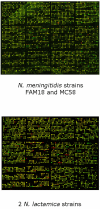The majority of genes in the pathogenic Neisseria species are present in non-pathogenic Neisseria lactamica, including those designated as 'virulence genes'
- PMID: 16734888
- PMCID: PMC1538595
- DOI: 10.1186/1471-2164-7-128
The majority of genes in the pathogenic Neisseria species are present in non-pathogenic Neisseria lactamica, including those designated as 'virulence genes'
Abstract
Background: Neisseria meningitidis causes the life-threatening diseases meningococcal meningitis and meningococcal septicemia. Neisseria gonorrhoeae is closely related to the meningococcus, but is the cause of the very different infection, gonorrhea. A number of genes have been implicated in the virulence of these related yet distinct pathogens, but the genes that define and differentiate the species and their behaviours have not been established. Further, a related species, Neisseria lactamica is not associated with either type of infection in normally healthy people, and lives as a harmless commensal. We have determined which of the genes so far identified in the genome sequences of the pathogens are also present in this non-pathogenic related species.
Results: Thirteen unrelated strains of N. lactamica were investigated using comparative genome hybridization to the pan-Neisseria microarray-v2, which contains 2845 unique gene probes. The presence of 127 'virulence genes' was specifically addressed; of these 85 are present in N. lactamica. Of the remaining 42 'virulence genes' only 11 are present in all four of the sequenced pathogenic Neisseria.
Conclusion: Assessment of the complete dataset revealed that the vast majority of genes present in the pathogens are also present in N. lactamica. Of the 1,473 probes to genes shared by all four pathogenic genome sequences, 1,373 hybridize to N. lactamica. These shared genes cannot include genes that are necessary and sufficient for the virulence of the pathogens, since N. lactamica does not share this behaviour. This provides an essential context for the interpretation of gene complement studies of the pathogens.
Figures


Comment in
-
The majority of genes in the pathogenic Neisseria species are present in non-pathogenic Neisseria lactamica, including those designated as virulence genes: response.BMC Genomics. 2006 May 30;7:129. doi: 10.1186/1471-2164-7-129. BMC Genomics. 2006. PMID: 16734889 Free PMC article.
References
-
- Guibourdenche M, Popoff MY, Riou JY. Deoxyribonucleic acid relatedness among Neisseria gonorrhoeae, N. meningitidis, N. lactamica, N. cinerea and "Neisseria polysaccharea". Ann Inst Pasteur Microbiol. 1986;137B:177–185. - PubMed
-
- Smith NH, Holmes EC, Donovan GM, Carpenter GA, Spratt BG. Networks and groups within the genus Neisseria: analysis of argF, recA, rho, and 16S rRNA sequences from human Neisseria species. Mol Biol Evol. 1999;16:773–783. - PubMed
-
- Denning DW, Gill SS. Neisseria lactamica meningitis following skull trauma. Rev Infect Dis. 1991;13:216–218. - PubMed
Publication types
MeSH terms
Associated data
- Actions
Grants and funding
LinkOut - more resources
Full Text Sources
Other Literature Sources

